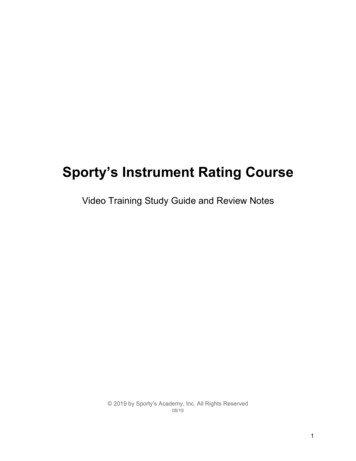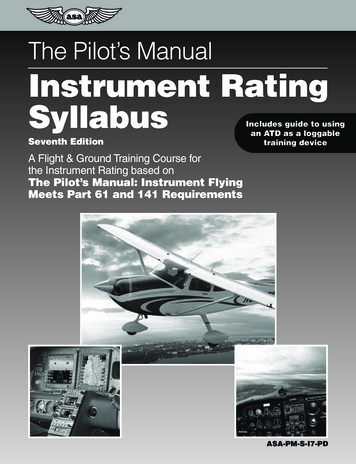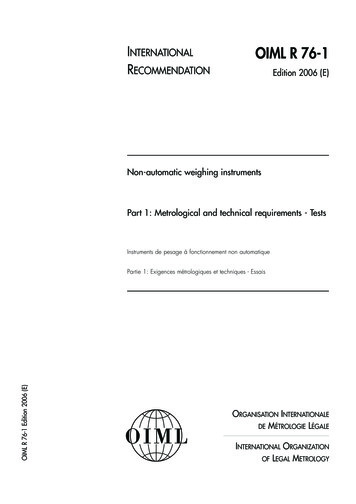
Transcription
Sporty’s Instrument Rating CourseVideo Training Study Guide and Review Notes 2019 by Sporty’s Academy, Inc. All Rights Reserved08/191
9 7Sporty’s Instrument Rating CourseChapter 1 – Instrument Flying Fundamentals15The IFR Flight to Chicago Midway5Getting Started in Your Instrument Training6The Instrument Scan7Straight & LLevel, Climbs & Descents8Closer Look: Flight Simulators9Flying In Turbulence10Air Facts: Staying Cool Under Fire11Turns and Steep Turns12
Flying the Glide Slope36Air Facts: The Simple Facts37Unusual Approaches38Air Facts: Vectors39Flying VOR Approaches40Closer Look: Procedure Turns41Holding42Circling Approaches43Visual Descent Points and DME44GPS Approaches45Chapter 4 – En Route IFR46Flight Planning & Chart Reading46Closer Look: FAA vs. Jeppesen47Checking Weather48Air Facts: A PC 4 IFR? OK49Building Margins50Air Facts: Conquering Cockpit Clutter51En Route Planning52Closer Look: Approach Lighting Systems53Planning For The Approach54Air Facts: Check It Out55Closer Look: Designer Approaches56Going To An Alternate57Air Facts: What Is The Alternative58Chapter 5 – Weather for IFR59Getting Weather Oriented59Ice60Air Facts: Ice As A Practical Matter61Closer Look: Ice Protection Systems62Thunderstorms63Closer Look: Thunderstorm Research64Cockpit Weather Information65Air Facts: ATC Radar For Weather Avoidance66Below Minimum Weather67Air Facts: Reading The Weather Signs68Turbulence69Middle Altitude Weather703
Air Facts: Nighttime WeatherChapter 6 – Advanced IFR7172Trainer To High Performance72Flight Director and HSI73Closer Look: IFR Resources74IFR Use Of The Autopilot75Air Facts: Night IFR76Engine Instrumentation77Air Facts: Keep It Running78Principles of Turbocharging79Oxygen Use80Pressurization81Closer Look: Flight Level Regulations82Air Facts: All-Weather Airplane?83Chapter 7 – FARs and Your Instrument Test84IFR Weather84Closer Look: Computer Testing85IFR Weather Data86Practical & Oral Testing87Closer Look: Test Taking Tips88Federal Aviation Regulations89Communications Loss Procedures90Air Facts: Communications Loss91Aircraft Instruments92Closer Look: Instrument Failure93Clearances And Flight Plans94Glass Checkride95ATC Expectations964
Chapter 1 – Instrument Flying FundamentalsThe IFR Flight to Chicago MidwayInstrument Rating Chapter 1 – Video Segment 1This section takes you on an actual IFR flight. The aircraft is a G1000 equipped Piper Malibu.The trip is from Clermont County Airport to Chicago Midway Airport.Review:1. This section stresses the importance of excellent weather planning and getting a properbriefing.2. The next step is the preparation and filing of a flight plan. This may be done online.3. The program takes you through the various radio calls en route with ATC and theimportance of occasionally monitoring the weather conditions.5
Getting Started in Your Instrument TrainingInstrument Rating Chapter 1 – Video Segment 2In this section you will learn to control the airplane more precisely, to navigate by radio aids, to dealwith air traffic control, and to make instrument approaches.Review:1. The requirements for an instrument rating are listed in FAR 61 and include both ground andflight instruction. There is a knowledge examination which covers regulations, aircraftinstruments, radio navigation, flight planning, en route, approach procedures, and weather.2. The criteria for the oral and practical portions of the test are listed in the Airman CertificationStandards (ACS).3. The practical test is structured to resemble an actual flight under instrument flight rules ininstrument conditions.6
The Instrument ScanInstrument Rating Chapter 1 – Video Segment 3In this section we will consider the fundamental skills you must develop as you become aninstrument pilot.Review:1. These skills are instrument scan, instrument interpretation, and airplane control.2. Most analog instrument panels are arranged in the standard "T" pattern.3. An effective scan is looking at the right instrument or instruments at the right time.Instrument flying substitutes the attitude indicator for the natural horizon.4. During your instrument flying, most of your scan time will be spent on the attitudeindicator.5. Don’t scan too rapidly, know what you’re looking for – that’s interpretation.7
Straight & Level, Climbs & DescentsInstrument Rating Chapter 1 – Video Segment 4In this section we will consider flying on instruments during straight-and-level, climbs, anddescents.Review:1. The control panel is grouped into pitch, bank, or power instruments.2. The attitude indicator gives a direct picture of the pitch attitude of the airplane. Theindirect instruments are the airspeed, vertical speed indicator, and the altimeter.3. Pitch correction
Closer Look: Flight SimulatorsInstrument Rating Chapter 1 – Video Segment 5In this section we will consider “flying” in a ground training device in order to earn some of yourinstrument time.Review:1. Ground trainers also have the advantage of allowing you to practice the difficult parts ofthe flight without spending a lot of time on the easy parts.9
Flying In TurbulenceInstrument Rating Chapter 1 – Video Segment 6In this section we will consider some of the difficulties in flying instruments in turbulentconditions.Review:1. The attitude indicator is quite important when instrument flying in turbulence - the onlyinstrument that gives a direct indication of bank.2. An airplane is not so stable in roll. It’s of primary importance to maintain roll control of theairplane regardless of how turbulent the air becomes.3. If you are in wind shear turbulence, the airspeed variations might be dramatic.4. In turbulence everything constantly changes.5. The most severe turbulence comes in or near a thunderstorm.10
Air Facts: Staying Cool Under FireInstrument Rating Chapter 1 – Video Segment 7Flying can present conditions that cause stress. Success, in these situations, demands selfcontrol.Review:1. Some reasons for stress might be turbulence, an accumulation of ice, or a mechanicalproblem.2. When a difficult problem occurs, don’t hesitate to ask for help. Run the appropriateemergency checklist, and if necessary, head for the nearest suitable airport.11
Turns and Steep TurnsInstrument Rating Chapter 1 – Video Segment 8In this section we will discuss turns, both standard rate and steep, while flying in reference toinstruments only.Review:1. The standard rate turn is one which changes the airplane’s heading at the rate of 3degrees per second.2. As you roll into a level turn, use the attitude indicator to set up the estimated angle ofbank.3. You'll also practice steep turns, which are made at bank angles of at least 45 , to helpfurther develop your instrument proficiency skills increase your scan rate.12
Closer Look: Electronic Flight Bags (EFB)Instrument Rating Chapter 1 – Video Segment 9Electronic Flight Bags, which are typically in the form of consumer tablets like an iPad orAndroid device, can help you plan cross-country flights, provide preflight weather briefings,display electronic approach charts, show G-P-S moving maps and much more.Review:1. Even with these advances in mobile computing technology, there’s a good chance yourflight instructor will still teach you how to use paper charts, leaving your tablet on thesidelines at least for a few lessons.2. FAR 91.21 requires that you verify your EFB (or any electronic device for that matter) willnot cause interference with the navigation or communications systems installed on theaircraft.3. You’ll need to follow the guidance of Advisory Circular AC 91-78, which says twoimportant things: it’s ok to use an EFB in lieu of paper charts provided the applicationyou use displays current data, and it recommends (but does not require) bringing abackup source of data (paper charts or 2nd EFB).4. Beyond the legalities, another important consideration is how to secure the tablet in away that allows for easy operation during all phases of flight, and to make sure it doesn’tfall out of reach when flying through rough air. The two most common forms are akneeboard or aircraft mounting fixture.5. If you’re depending on a tablet as a primary reference for charts, plus situationalawareness, weather, and so much more, you need to be proficient with it.6. A tablet is only a legal replacement for charts as long as the aviation data in the app iscurrent, so get in the habit of updating the databases every month.7. Finally, resist the urge to focus too much on your tablet and let it become a distraction,no matter how impressive its capabilities are.13
Vacuum & Pressure SystemsInstrument Rating Chapter 1 – Video Segment 10In this section we will discuss why air driven attitude and heading instruments could fail byexamining the vacuum and pressure systems.Review:1. The air driven gyros, which stabilize the attitude and heading indicators, are usuallycalled the vacuum instruments.2. Another alternative to the vacuum pump is the electrically operated attitude and headingindicators.3. Glass equipped airplanes may or may not have a vacuum system. Some manufacturersinstall a basic vacuum system to drive the backup attitude indicator.14
Partial PanelInstrument Rating Chapter 1 – Video Segment 11In this section we will discuss partial panel instrument flight. It can be described as controllingthe airplane by reference to a limited number of flight instruments. These instruments oftenconsist of the airspeed and turn and slip indicators as well as the clock and magnetic compass.Review:1. Instrument failure could be caused by vacuum, electrical, or pitot-static source failure.2. If your airplane is equipped with digital instruments, an electrical failure may cause youto rely on the standby analog instruments – airspeed indicator, attitude indicator, andaltimeter.3. For Primary Flight Display failures, many glass equipped airplanes are capable ofdisplaying the full instrument panel on an alternate display.4. The attitude indicator is usually the first instrument to slowly show a pump failure, usuallyby incorrect pitch indications.5. When a failure happens in instrument conditions, ask ATC for help.6. Avoid the tendency to over control the airplane in partial panel conditions.7. In the event of an actual failure, the track indication on your GPS can provide a backup.15
Air Facts: Glass Cockpit FlyingInstrument Rating Chapter 1 – Video Segment 12Glass cockpit flight instrument systems are becoming more and more common in today’sairplanes and replace the 6 traditional round flight instruments.Review:1. Unlike traditional cockpits, which rely on vacuum-powered instruments to display attitudeand heading, glass cockpits use solid state sensors.2. These Attitude Heading Reference Systems (AHRS) drive the attitude displays are muchmore reliable than mechanical vacuum pumps, and the heading indicator does notrequire constant resetting.3. There are some new challenges when flying with glass cockpits - first, there isn’t a lot of“glance value” on an integrated glass cockpit. You’ll need to pause and read the exactnumbers on the airspeed and altitude tapes.4. Set the bugs on the primary flight display whenever possible. Most glass cockpits haveknobs that allow the pilot to set bugs for the altitude and heading, and some even haveone for the airspeed.5. Get to know how the trend lines work. These are usually magenta lines next to the tapeson the primary flight display, showing what the airspeed or altitude will be six seconds inthe future.6. Finally, learn the most common profiles for the airplane you fly - you’ll spend less timechasing tapes and adjusting power.7. Glass cockpits can vary significantly between manufacturers and even models, so you’llwant to spend some time reading the manual for the system you fly.8. Many newer options replace a single instrument with a digital display. These hybridglass-steam cockpits are more affordable than complete cockpits and more reliable thanvacuum pumps, but it’s critical you understand which instruments are driven by whichsensors.16
ConclusionInstrument Rating Chapter 1 – Video Segment 13And with that, we conclude Chapter 1 of the instrument series. The goal in your first fewinstrument lessons is to become comfortable with the airplane in the different flight modes whileusing only the instruments. Soon, you’ll develop a sense of familiarity with this way of doingthings and you'll begin to wonder how you flew as well as you did before this training. It's reallyquite an accomplishment. Undoubtedly, you'll want to review this chapter several more times,because we did present a lot of information.17
Chapter 2 – Air Traffic Control and IFRSeparation & Other StandardsInstrument Rating Chapter 2 – Video Segment 1Let’s look at the beginnings of federal regulations and how traffic was controlled. Today, the airtraffic service is responsible for developing plans, establishing standards, and implementing airtraffic control systems.Review:1. The two ATC functions of most interest to instrument pilots are preflight and in-flightservices, and aircraft separation during flight in controlled airspace.2. A pilot has the sole responsibility to see and avoid other aircraft, terrain, and obstructionswhen weather permits – with ATC or not.3. Vertical separation depends on your altitude. It increases from 1,000 feet to 2,000 feetabove flight level 410.4. When you are out of radar coverage, pilots of IFR flights are expected to make positionreports.5. Both the Jeppesen and FAA charts show compulsory reporting points as solid triangles.18
The Basic StructureInstrument Rating Chapter 2 – Video Segment 2In this section we present an overview of both the air traffic control system and airways. We willalso consider what our responsibilities are when under ATC’s control. In subsequent chapters,you'll see, in more detail, how these systems work.Review:1. You must file an IFR flight plan and receive an ATC clearance prior to entering controlledairspace when the weather is less than VFR.2. Aircraft are flown IFR in Class G airspace without a flight plan or a clearance. All theother regulatory and procedural requirements for conducting an IFR flight must becomplied with.3. IFR departures and arrivals for airports, not within approach control airspace, arecontrolled by the center. If there is no operating control tower on the field, ATC will notautomatically close your flight plan, you must.4. Centers are divided into sectors, the working elements of a center. Each sector hasspecific geographic boundaries and is under the control of a team of controllers.19
Air Facts: Talking to ControllersInstrument Rating Chapter 2 – Video Segment 3One of the things that you can do to better understand Air Traffic Control is visit an ATC facilityand talk with some of the controllers that work there.Review:1. It's ok to file direct routing on your IFR flight plan, but you may get assigned a preferreddeparture route when leaving from congested airspace.2. Controllers will often allow you to go direct to your destination while en route, but adifferent controlling facility further down your route may need to issue you a routechange to keep you clear of special use airspace or put you on an arrival procedure.3. ATC always saves the first IFR altitude for departures and arrivals in terminal airspace.4. It's ok to ask for an altitude that's wrong for the direction of flight if needed for weather –the controller can coordinate to make that happen.5. Pilots need to be forthcoming on the radio when something isn't right, whether it bein-climate weather, or the failure of a piece of equipment on the airplane.20
IFR En RouteInstrument Rating Chapter 2 – Video Segment 4In this section we’ll investigate the en route portion of IFR flying. To get the most out of thesystem, you need to understand the constraints of the en route air traffic control system as wellas the protection that's built into the system.Review:1. The altitude that you filed may not be available in busy areas. The minimum en routealtitudes, MEAs, are often low in flat country. The minimum obstruction clearancealtitudes, MOCAs, are even lower.2. Radar coverage is not provided for at these minimum altitudes.3. When en route, you have to adapt to terminal airspace requirements. Even if you get aclearance through the terminal area, there will likely be vectoring to keep you clear ofarrivals and departures.4. Notify the controller any time you are unable to maintain a climb or descent rate of atleast 500 feet per minute and if your cruising airspeed varies or you experiencecommunication or navigation failure.5. If you have an approved GPS or other RNAV system, you can often ask to fly long directlegs when en route.6. Review VOR operation, especially CDI deflection in various situations. For example, onedegree deflection of the CDI needle 60 miles from the station equals one mile off theairway centerline.21
Departing the Terminal AreaInstrument Rating Chapter 2 – Video Segment 5In this section we’ll look at the various departure procedures that are in place to help youtransition from the runway to the IFR en route system.Review:1. A Standard Instrument Departure (SID) is a graphic departure procedure designed byATC to standardize traffic flow, ensure aircraft separation and provide obstacleclearance from the terminal area to the en route environment.2. You can find SIDs in your favorite mobile app in the same location as the instrumentapproach charts. The more complex procedures will be displayed on two separatepages, with the first showing a graphic of the routing, and the second showing a textdescription.3. The chart will provide both a departure control frequency and top altitude to climb toduring the procedure – ATC may omit these when issuing your IFR clearance to savetime.4. If you don't wish to use standard instrument departures, you should note this in theremarks section of your flight plan.5. Another type of instrument departure is the ODP, or obstacle departure procedure.Textual ODPs are located in the Takeoff Minimums section in mobile apps, while graphicODPs are grouped in with the SIDs, and usually include the word “Obstacle” in the title todifferentiate them from traditional SIDs.6. An inverse "T" printed in the notes section of FAA approach charts indicates that theairport has a published obstacle departure procedure, and/or non-standard takeoffminimums.7. The takeoff minimums do not apply to Part 91, not for hire operations, but it is a goodidea to abide by them anyway, especially in unfamiliar terrain.8. The standard takeoff minimums that apply to "for hire" operations are 1 statute mile if anairplane has 1 or 2 engines and one half mile for airplanes with 3 or more engines.9. Obstacle clearance for a departure is based on the aircraft climbing at least 200 feet pernautical mile and climbing to 400 feet above the departure runway elevation beforeturning unless otherwise specified in a departure procedure.10. There is a chart in the Digital Terminal Procedures Supplement that will convert requiredclimb gradient and groundspeed to a required rate of climb, which is the moremeaningful value in the airplane.11. If the controller issues a “Climb via the SID” clearance, you would be expected to complywith all the altitude restrictions on the procedure and then level off at the top altitudenoted on the chart.22
12. The main route of a graphical SID is depicted with a thick black line, while the transitionroutes are shown with a thin black line.13. You can find SIDs in your favorite mobile app in the same location as the instrumentapproach charts. The more complex procedures will be displayed on two separatepages, with the first showing a graphic of the routing, and the second showing a textdescription.23
IFR ArrivalsInstrument Rating Chapter 2 – Video Segment 6Standard Terminal Arrival Routes (STARs) are used for IFR arrivals into busy airspace, andgenerally end at a fix from which you will be vectored to the final approach course.Review:1. If you do not wish to fly a STAR, note that fact in the remarks section of your flight plan.2. Many arrival procedures were created in the days before GPS and relied on VOR andDME as the primary means for navigation and identifying intersections.3. Today you’ll see just as many procedures designed to be flown using GPS, which willinclude the notation “RNAV” in the title. These incorporate a series of waypoints to fly,just like an RNAV/GPS instrument approach, and are flown using an IFR-approved GPSnavigator.4. The architecture of the system is such that a descent gradient of 250 to 350 feet pernautical mile is expected of arrivals.5. During the arrival, tune in the ATIS in advance and let the approach controller know youhave the latest information on the initial check-in with them.6. To further reduce ATC communications during the arrival phase, the controller may issuea “Descend Via” clearance when flying a STAR. This requires you to comply with thepublished procedure’s lateral path, altitude and airspeed restrictions.7. After accepting a "Descend Via" clearance, you are expected to initiate altitude andairspeed changes on your own until reaching the lowest altitude published on theprocedure.8. There are two approaches that are not procedural and are based on a deal between thepilot and controller. They are the visual approach and contact approach.9. You must have the airport, or an identified preceding aircraft to follow, in sight, before avisual approach will be approved.10. You must be clear of clouds and have a mile flight visibility and a mile visibility reportedat the airport for a contact approach. The airport must have an approved instrumentapproach procedure. The pilot is responsible for obstruction clearance during a contactapproach.11. If you are landing at a controlled airport, the tower will automatically cancel your IFRflight plan.12. At nontowered airports you can either cancel with ATC on the radio before landing or onthe ground after landing over a remote frequency or phone number.24
Closer Look: ATC TechnologyInstrument Rating Chapter 2 – Video Segment 7As a pilot you aren't expected to know the technical details of air traffic control technology, butthere are benefits to understanding the other side of the pilot-ATC relationship.Review:1. As you fly along in the company of an air traffic controller, your airplane is a data blockon his screen. This basically tells who you are, how high you're flying, your groundspeedand your destination.2. ADS-B is replacing ground-based radar as the main way for ATC to identify andseparate traffic, and it requires each aircraft to be equipped with an ADS-B Outtransponder.3. These ADS-B transmissions are received by a network of over 700 ground stations, thenrelayed to a controller’s screen.4. The system will also provided an automated alert to get the controller’s attention ifthere’s a collision threat between two aircraft.5. The controller’s radar will also paint precipitation, so don’t hesitate to ask his opinion ifyou’re unsure about potential weather ahead. Just remember that ATC radar is designedto see airplanes, not weather, so it isn’t as detailed as the NEXRAD radar you’re used toseeing online.6. A computer is always monitoring air traffic and will alert ATC about the loss of legalseparation, 1,000 feet and 5 miles for low altitude en-route traffic between airplanes.7. The controller has a system that can project flight paths and anticipate future conflicts. Ifthere's a potential conflict, then possible solutions can go into the computer to seewhether or not they will solve the potential conflict.8. If a radar controller in a busy area gives you a round-about IFR routing and the weatheris excellent, you might ask about a VFR clearance through the Class B or C airspace.25
IFR CommunicationsInstrument Rating Chapter 2 – Video Segment 8In this section we’ll investigate the communication process in IFR flying. The measure ofsuccess here is found in understanding, on both sides of the conversation.Review:1. You must know exactly what the controller wants you to do. Make sure there isunderstanding before a subject is dismissed as completed.2. Good phraseology is mostly logical. Use whatever words are needed to get the messageacross but avoid jargon or CB talk.3. Try to use words from the Pilot/Controller Glossary. You can find it online and it’s oftenincluded with the AIM, when printed. This glossary is also used by the controllers.4. Some basic communications techniques: Listen for a moment before you transmit, knowwhat to say before you key the mike, if you call and nobody answers, wait a fewmoments before calling again, and always use your call sign.5. If you have a radio communications failure in instrument conditions, continue on the lastassigned route and altitude, or at the minimum en route altitude or altitude ATC told youto expect, whichever is higher. Set your transponder to 7600, the code for radio failure.6. If the radio failure occurs in VFR conditions, or if you encounter VFR after the failure,continue the flight under VFR, and land as soon as practicable.7. The basic format for a radio call is to identify the facility you are calling, identify yourself,and state your message.8. An IFR clearance should be written down, in rote fashion, to be understood later. Next,read it back to make sure you got it right. Then, try to understand the clearance.9. Here are a few of the mandatory reporting situations: We must report to ATC when:Encountering hazardous weather and any unforecast weather conditions, with anyinformation relating to the safety of the flight, if any avionics malfunction, if you deviatefrom your clearance, and when vacating an altitude for a newly assigned altitude. Youwill want to check out the others as well.26
Air Facts: Radio ProInstrument Rating Chapter 2 – Video Segment 9Talking on the radio is an important part of flying IFR, and in this section we'll review seven badcommunication habits that can make you sound less professional and potentially lead to safetyissues.Review:1. Avoid the phrase "with you" when first checking on with a new controller.2. When ATC clears you for something, they usually expect a readback of that clearance,just to make sure both sides understand what’s about to happen. Simply stating "Roger"is not acceptable.3. Avoid starting every transmission with "Ah" or "And" when talking to ATC.4. Avoid giving too much information to ATC when you have a request, since they may notbe ready to process it all right away when the frequency is busy.5. Use the guard frequency, 121.5 MHz, for official business only.6. Refrain from giving position reports in reference to IFR fixes at nontowered airports –distance and direction will be much useful for non-IFR pilots in the pattern.7. Do not use the phrase "Any traffic in the area please advise" when first switching over toa nontowered airport CTAF frequency.27
Learning the SystemInstrument Rating Chapter 2 – Video Segment 10In this section we’ll investigate instrument charts, some rules for IFR, and the procedures foroperating in the air traffic control system.Review:1. Always use current charts. Airways, approach procedures, NAVAID frequencies, andlocations as well as a lot of other data that is on the charts may change.2. Some of the rules for IFR are in Part 61 of the regulations, such as the recent experiencerequirements, logging of flight time, and the requirements for an instrument rating.3. Part 91 has the rules for IFR operations, equipment, and the inspections required.4. NTSB Part 830 covers pilot responsibilities for aircraft accident and incident reporting.5. Air traffic control procedures are in the Aeronautical Information Manual, AIM.6. The AIM is designed to provide pilots with basic flight information and ATC proceduresrequired to fly in the national airspace system of the United States.7. Another resource for the pilot is the Notices to Airmen publication, available on theinternet and by subscription. It includes amendments to instrument approaches, theAirport/Facility Directory, and other current charts.28
Air Facts: Flight Plans, Fact & FictionInstrument Rating Chapter 2 – Video Segment 11A lot of the information on an IFR flight plan is for purposes other than air traffic control, and inthis section will explain the purposes of each.Review:1. The ICAO flight plan form that has become the standard way to file a flight plan - it asksfor detailed avionics specifications, survival equipment and much more, but the controllerdoesn't really need to know the color of your airplane or how many life rafts you have.2. ATC is mainly concerned with the proposed route, altitude, and speed. The other itemson your flight plan are for search and rescue purposes, should you fail to arrive.3. The factual parts of the flight plan include the airplane number, type, speed, departurepoint, fuel on board, our name and address, the number of people on board, and thecolor of the airplane.4. Some of the changeable items might include, the requested cruising altitude, route offlight, the time of departure, the destination, the time en route, and the alternate airport.5. The clearance is kept on file for two hours after your proposed time off.6. Your ultimate alternate should be based on a continuous check of weather while enroute.7. Our flight plan is an outline of what we propose. Items can change.29
The Pilot’s Role In The SystemInstrument Rating Chapter 2 – Video Segment 12In this section we’ll investigate the pilot’s role in the ATC system.Review:1. The responsibilities of pilots and air traffic controllers are clear. The pilot is directlyresponsible for, and is the final authority as to, the safe operation of the aircraft.2. The pilot is authorized, in an emergency requiring immediate action, to deviate from aclearance or from regulations.3. The
Getting Started in Your Instrument Training Instrument Rating Chapter 1 - Video Segment 2 In this section you will learn to control the airplane more precisely, to navigate by radio aids, to deal with air traffic control, and to make instrument approaches. Review: 1.The requirements for an instrument rating are listed in FAR 61 and include .










